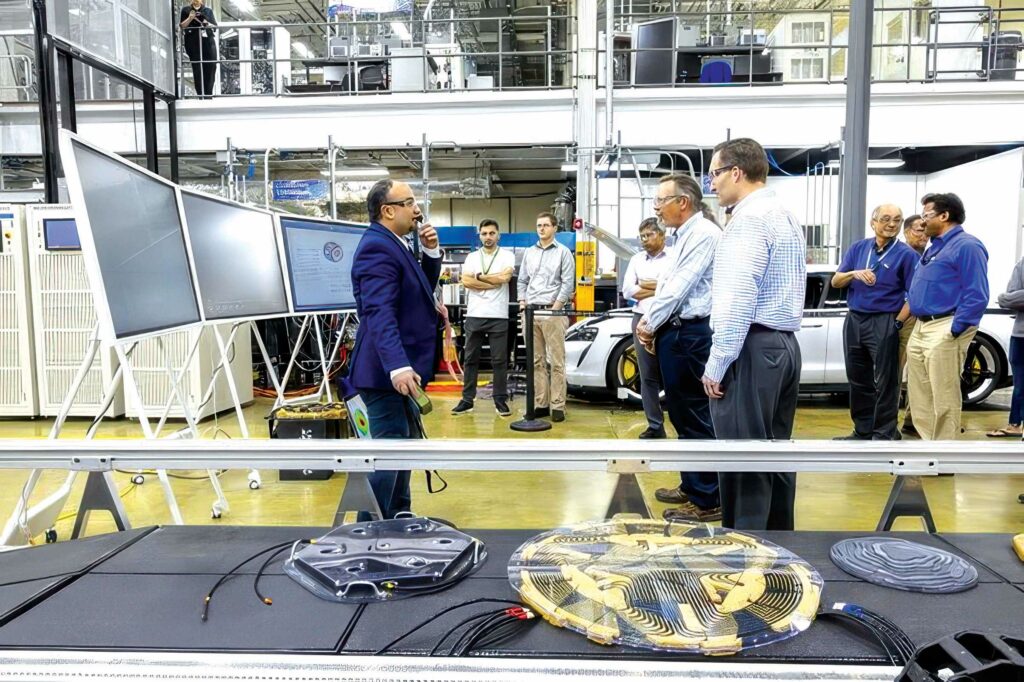Charging forward with polyphase

(Image courtesy of Oak Ridge National Laboratory)
A polyphase wireless power transfer system has achieved a record 270 kW charging rate, writes Nick Flaherty. Researchers in the Power Electronics and Electric Machinery Lab at the Oak Ridge National Laboratory (ORNL) in the US successfully demonstrated the first 270 kW wireless power transfer to a Porsche Taycan at the end of a three year project with Volkswagen.
Existing wireless charging systems for cars are currently under development for up to 11 kW power levels with up to 92% efficiency, but are difficult to equip using conventional large, heavy wireless power transfer systems. The vehicle can’t support the charging hardware due to space, weight and volume limitations.
In view of that the ORNL team used lightweight polyphase electromagnetic coupling coils with a diameter of
485 mm (just over 19 in) that provide higher power density in the smallest coil possible. This process is similar to the wireless charging of small consumer devices, but the unique geometry and design of the polyphase coils enable the transfer of much higher power levels using rotating magnetic fields generated by the coil phase windings to boost the power. The charging system was seamlessly integrated into the undercarriage of the Taycan.
The wireless power transfer technology also includes protection systems that prevent exceeding voltage and current limits, overheating and short-circuiting. These systems can initiate shutdown procedures in the event of power interruptions or other unexpected conditions that would interfere with safe power transfer.
The system can achieve a 50% increase in state of charge within 10 minutes with more than 95% efficiency. The power transfer was conducted over a 120 mm (4.75 in) gap between the ground and the coil mounted to the underside of the vehicle.
“The receiver coil designed for the Porsche Taycan research vehicle can achieve 8 to 10 times higher power density compared to existing systems,” said ORNL’s Omer Onar, leader of the Vehicle Power Electronics group and lead researcher on the Porsche demonstration. “Per kilowatt, this is also the lightest charging system in the world.”
The team had previously developed a 100 kW wireless system using a similar coil design, and ORNL and Volkswagen said they plan to continue working together to further develop the
270 kW charging prototype by developing it into a more cost-effective and manufacturable system. The 100- and 270-kW demonstrations mark the first time ORNL’s polyphase system has been tested on electric vehicles.
“We’re also working with Volkswagen on developing a polyphase system for residential charging applications and collaborating on the development of a lightweight enclosure design that will improve mechanical, electrical, thermal and magnetic performance,” said Onar. “Our goal is to mature the technology so that it’s ready for deployment in production vehicles.
“We’re working to reach much higher charge rates for other types of vehicles, including investigating achieving a significantly higher charge for heavy-duty freight and transport trucks,” Onar added.
“This achievement gets us one step further to the reality of a future where an electric vehicle can pull into a charging station and recharge in the same time it would take to walk into a store and grab a snack,” said Burak Ozpineci, corporate fellow and distinguished researcher who leads vehicle and mobility systems research at ORNL. “The driver doesn’t have to do anything but park. We’re even exploring ways that this technology could be used to charge a vehicle in motion on the roadway.”
The electric vehicle demonstrations were conducted in the Grid Research Integration and Deployment Centre at ORNL. These demonstrations are part of research to develop a system that delivers 250 to 300 kilowatts to electric vehicles and reduces charging time to 15 minutes or less.
Click here to read the latest issue of E-Mobility Engineering.
ONLINE PARTNERS





















